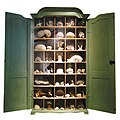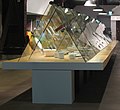Portal:Museums
The Museums Portal
A museum (/mjuːˈziːəm/ mew-ZEE-əm) is an institution dedicated to displaying and/or preserving culturally significant objects. Many museums have exhibitions of these objects on public display, and some have private collections that are used by researchers and specialists. Compared to a library, a museum hosts a much wider range of objects and usually focus around a specific theme such as the arts, science, natural history, local history, and other topics. Public museums that host exhibitions and interactive demonstrations are often considered to be tourist attractions, and many museums attract large numbers of visitors from outside their host country, with the most visited museums in the world regularly attracting millions of visitors annually.
Since the establishment of the earliest known museum in ancient times, museums have been associated with academia and the preservation of rare items. Museums originated as private collections of interesting items, and not until much later did the emphasis on educating the public take root. (Full article...)
Selected museum

The Palazzo Pitti (Italian: [paˈlattso ˈpitti]), in English sometimes called the Pitti Palace, is a vast, mainly Renaissance, palace in Florence, Italy. It is situated on the south side of the River Arno, a short distance from the Ponte Vecchio. The core of the present palazzo dates from 1458 and was originally the town residence of Luca Pitti, an ambitious Florentine banker.
The palace was bought by the Medici family in 1549 and became the chief residence of the ruling families of the Grand Duchy of Tuscany. It grew as a great treasure house as later generations amassed paintings, plates, jewelry and luxurious possessions.
In the late 18th century, the palazzo was used as a power base by Napoleon and later served for a brief period as the principal royal palace of the newly united Italy. The palace and its contents were donated to the Italian people by King Victor Emmanuel III in 1919.
The palazzo is now the largest museum complex in Florence. The principal palazzo block, often in a building of this design known as the corps de logis, is 32,000 square metres. It is divided into several principal galleries or museums detailed below. (Full article...)
Selected interior image
Selected general article

Cultural heritage management (CHM) is the vocation and practice of managing cultural heritage. It is a branch of cultural resources management (CRM), although it also draws on the practices of cultural conservation, restoration, museology, archaeology, history and architecture. While the term cultural heritage is generally used in Europe, in the US the term cultural resources is in more general use specifically referring to cultural heritage resources.
CHM has traditionally been concerned with the identification, interpretation, maintenance, and preservation of significant cultural sites and physical heritage assets, although intangible aspects of heritage, such as traditional skills, cultures and languages are also considered. The subject typically receives most attention, and resources, in the face of threat, where the focus is often upon rescue or salvage archaeology. Possible threats include urban development, large-scale agriculture, mining activity, looting, erosion or unsustainable visitor numbers. (Full article...)
Did you know...
- ... that the names of Harvey Meyerhoff, Elie Wiesel, and Bill Clinton are carved into the cornerstone of the United States Holocaust Memorial Museum, according to Meyerhoff's daughter?
- ... that the Museum of Classic Sci-Fi is located in the cellar of a house in Allendale, Northumberland?
- ... that Carl Cotton was the first black taxidermist to work at the Field Museum of Natural History after being hired in 1947?
- ... that the James Norman Hall Museum is where the The Bounty Trilogy was written?
- ... that in 1999 two necklaces were repatriated to the Cook Islands National Museum from a museum in Angus, Scotland?
- ... that the British Museum's 2012 exhibition Hajj: Journey to the Heart of Islam included textiles from the Kaaba that were described as bringing "a visceral artistic buzz to the display"?
Get involved
For editor resources and to collaborate with other editors on improving Wikipedia's Museums-related articles, see WikiProject Museums.
Selected exterior image
Selected type of museum
A national history museum or national historical museum is a history museum dedicated to presenting artifacts and exhibits reflecting the history of a particular nation, usually its home country. The earliest public museums, the Ashmolean Museum in Oxford and the Louvre Museum in Paris, were focused on natural history and art, respectively, and not necessarily on subjects related to the history of any nation. Following Napoleon's use of the Louvre as a center of national pride during his reign, other countries began to use museums not just to store artifacts of aesthetic or educational value, but to portray the country itself in a positive light.
Historically, some national history museums have been used purely as propaganda tools through which governments attempt to convey an official history. For example, "the Nazi regime employed the museum as a deliberate tool of propaganda and 'public education'". It has further been argued that "the very idea of an officially sponsored national history museum is simply outdated" in light of the trend towards pluralistic interpretation of artifacts. On the other hand, it has been argued that: "To create a national history museum that discards unitary national narratives as well as causal trajectories (the teleology of the nation)—in effect to subvert the form—is probably impossible". One concern of national history museums, therefore, is how to fairly and neutrally depict negative periods in a nation's own history. (Full article...)
Subcategories
Subtopics
Lists
- Museums
- Most visited museums (by region)
- Art museums: most visited, largest
Types
- Art museum
- Agricultural museum
- Archaeology museum
- Architecture museum
- Artillery museum
- Aviation museum
- Biographical museum
- Cabinet of curiosities
- Ceramics museum
- Children's museum
- Community museum
- Computer museum
- Design museum
- Dime museum
- Ecomuseum
- Economuseum
- Ethnographic village
- Farm museum
- Fashion museum
- Folk museum
- Food museum
- Green museum
- Hair museum
- Hall of Memory
- Heritage centre
- Historic house museum
- Human rights museum
- Imaginarium
- Interpretation centre
- Jewish museum
- Lapidarium
- Lighthouse museum
- Living museum
- Local museum
- Maritime museum
- Migration museum
- Mobile museum
- Museum ship
- National history museum
- Natural history museum
- Open-air museum
- Palace museum
- Postal museum
- Prefectural museum
- Print room
- Private museum
- Regimental museum
- Schatzkammer
- Science fiction libraries and museums
- Science museum
- Sex museum
- Sculpture garden
- Technology museum
- Textile museum
- Torture museum
- Toy museum
- Transport museum (list)
- University museum
- Virtual museum
- Wax museum
- Writer's home
Related
Associated Wikimedia
The following Wikimedia Foundation sister projects provide more on this subject:
-
Commons
Free media repository -
Wikibooks
Free textbooks and manuals -
Wikidata
Free knowledge base -
Wikinews
Free-content news -
Wikiquote
Collection of quotations -
Wikisource
Free-content library -
Wikiversity
Free learning tools -
Wiktionary
Dictionary and thesaurus






































































